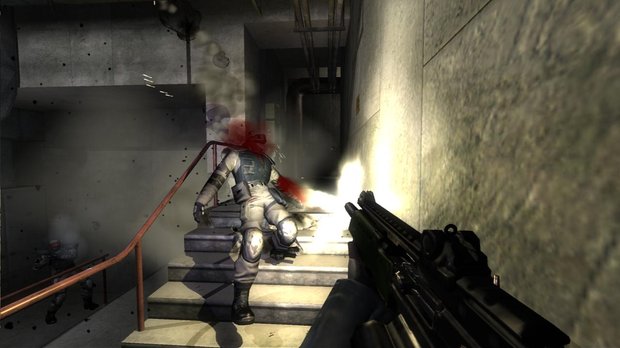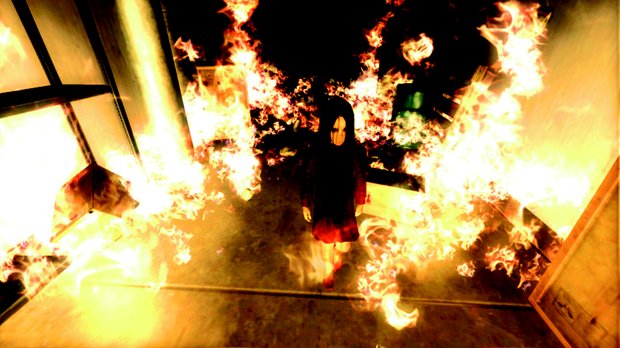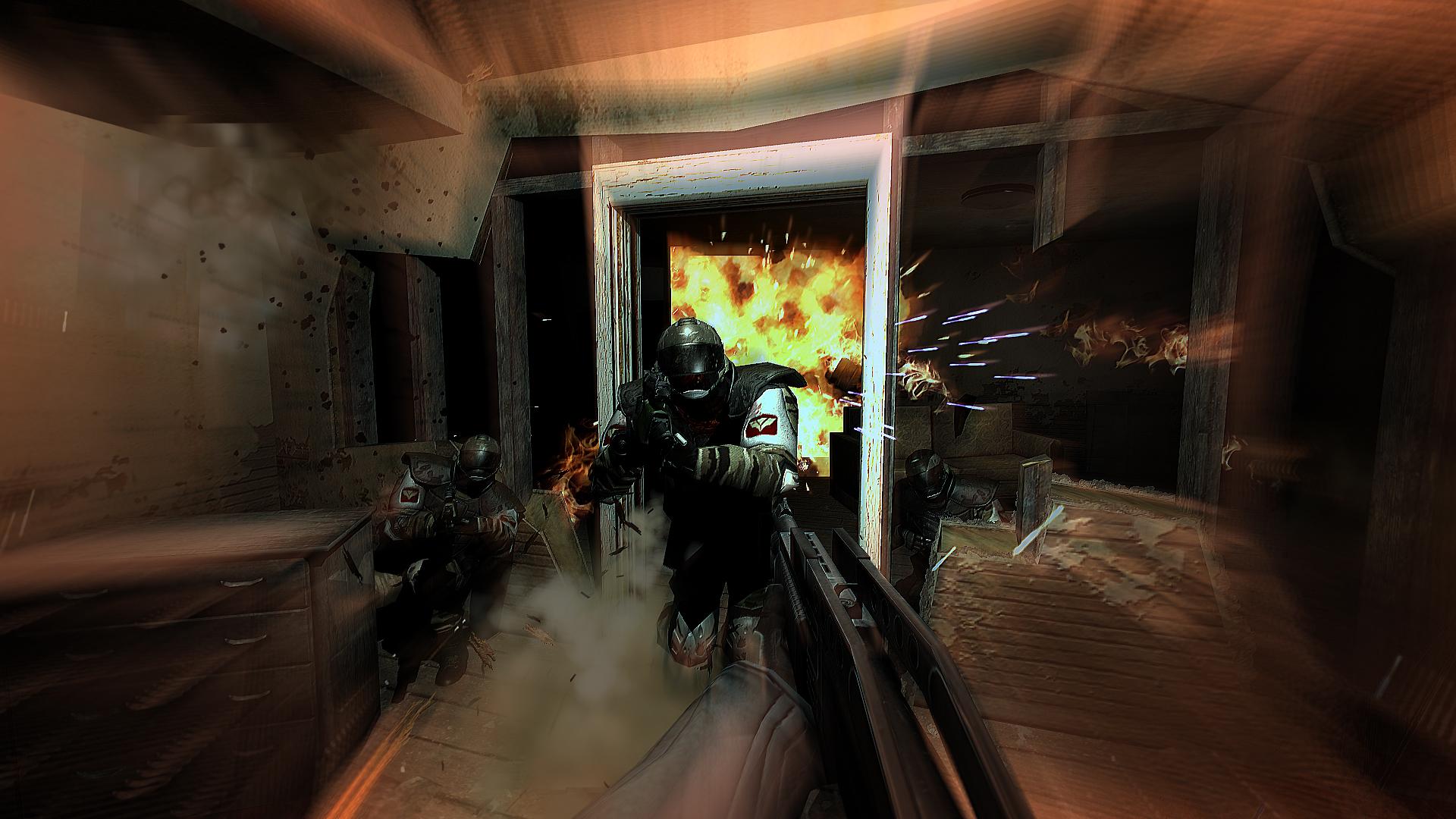Want slow-mo blood geysers and soul-choking dread? Play F.E.A.R.
In honor of F.E.A.R.'s 10th anniversary on October 18th, we're repromoting this article from 2013 that extolls the virtues of this terrifying, ahead-of-its-time shooter. Take it away, Dave!
F.E.A.R. technically cost me about £240 back in 2005. I don’t regret spending a penny of it. In fact if you count my recent re-buy in this year’s summer Steam sale, it’s up to about £245 now. Still no regrets.
How did this exceptionally expensive purchase come about? A simple case of good old fashioned not-reading-the-required-specs-properly. Back in 2005 I had a beast of a PC. It’s probably more of a mewling three-legged kitten now, but back then it was a snarling, flame-eyed Cerberus of a thing. I got it for video editing at university, you see. But once I’d graduated it would clearly have a worthy secondary purpose. Games. I’d already run Doom 3 on it, so its credentials were confirmed, or so I thought. Having seen F.E.A.R. running on a friend’s weaker, punier PC and loved every second of it (for reasons that I’ll detail a little later on) I realised that I needed it in my life. I went out, bought a copy, installed it, and then stared blankly at the screen as it stubbornly refused to run.

Turns out that my friend’s PC might have been puny overall, but he’d ploughed his entire budget into a monster of a graphics card. And F.E.A.R. needed an absolute demon of a thing back then. I had two options. I could take the game back with my tail between my legs, or I could drop a chunk of my savings on making my rig flat-out unholy. I did the obvious, sensible thing.
But the important thing to know with F.E.A.R. is that the graphics – stupendous at the time and still powerfully affecting now – aren’t just a cosmetic flourish. You’ll be superficially impressed the first time that F.E.A.R. flutters its dynamically lit eyelashes at you, all starry-eyed with a golden supernova of particle effects. But the reality is that while F.E.A.R. initially turned heads by looking just so… damn… cool… its sumptuously directed graphical effects support and inform its unique game design every step of the way.
F.E.A.R. is a horror-shooter. Don’t take that statement lightly. F.E.A.R. is the real thing, and there are precious few of those in existence. I’m not talking about the sort of game you’re probably now thinking of. I’m not comparing F.E.A.R. to Resident Evil 5 or Dead Space. It’s not a game in which you fight monsters, suffer cheap jump-scares, and ultimately become dulled to the telegraphed shocks and gruesome enemies through over-exposure. F.E.A.R. is a genuinely unsettling, chokingly atmospheric horror game that also happens to be one of the most dynamic, adrenalin-charged, spectacularly balls-out FPS ever made. And every element of it is terrifying.

Starting with the obvious, “traditional” horror stuff, even here F.E.A.R. is anything but. Yes, it’s a game of dark, grey-walled corridors and creepy little ghost girls, but the game’s execution of the scripted ghost train experience is far more subtle, disquieting and intelligent than most. Eschewing the usual “quiet bit, quiet bit, LOUD SHOUTY MONSTER” pacing of many games, F.E.A.R. twists and spins the player’s expectations until they don’t know which way is up. Tense build-ups will lead to nothing. Quiet, calm-down sections will suddenly turn horrific without warning. Sound cues will double-bluff and wrong-foot at every turn. And everything is wrapped up in cold, forbidding atmosphere that’s chilling like the breeze on a grey October morning.
Sign up to the GamesRadar+ Newsletter
Weekly digests, tales from the communities you love, and more
Many have criticised F.E.A.R.’s heavy use of angular grey corridors, but to me they were and still are perfect. Given feverish life by the game’s severe dynamic lighting, their starkness gives F.E.A.R. an oppressive yet indifferent personality that more detail and a fuller palette would have absolutely murdered.
And speaking of absolute murder, I must now attempt, in a flailing, hopeless way, to evoke F.E.A.R.’s combat. Almost entirely avoiding any kind of supernatural enemies, F.E.A.R. puts you up against something far more scary. Brutal, human intelligence. Sporting far better enemy AI than any shooter before or since, F.E.A.R.’s enemy combatants are as utterly believable as they are ceaselessly intimidating. Able to appraise and react to any evolving combat situation on the fly as individuals or as part of a team – and ruthlessly aggressive with it – they never display a hint of canned behaviour, their masterful, athletic combat ability given an even scarier sense of life by their harrowingly believable animation.

Always aware of their environment and displaying a complete tactical mastery of using it to their advantage, they turn F.E.A.R.’s complex, rabbit-warren sandboxes into labyrinthine death-traps, where the killing shot could come from any direction at any time, and often long after you think you’ve taken the last guy down.
As such, F.E.A.R.’s much emulated slow-mo mode is no mere aesthetic flourish. It’s a damn near required survival tool, its rationed use rapidly adding a major element of tactical thought to the game's skirmishes. And once unleashed, ye gods, what a spectacle it is. When combat is in full flow, bullet-trails carving furrows through the air, distortion bubbles ripping outwards from detonated grenades, flame devouring the environment and those particle supernovas raining angry fireworks through slowly erupting clouds of blood, there are few comparable sights to behold in all of gaming. Beautiful, exhilarating and viscerally scary all at the same time, F.E.A.R.’s slow-mo combat is like a lucid fever-dream set in an industrialised Hell.
F.EA.R. It’s scary. In ways that no other game is. You should play it.



